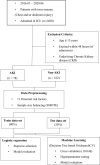Comparing machine learning and logistic regression for acute kidney injury prediction in trauma patients: A retrospective observational study at a single tertiary medical center
- PMID: 37603521
- PMCID: PMC10443755
- DOI: 10.1097/MD.0000000000034847
Comparing machine learning and logistic regression for acute kidney injury prediction in trauma patients: A retrospective observational study at a single tertiary medical center
Abstract
Acute kidney injury (AKI) is common in patients with trauma and is associated with poor outcomes. Therefore, early prediction of AKI in patients with trauma is important for risk stratification and the provision of optimal intensive care unit treatment. This study aimed to compare 2 models, machine learning (ML) techniques and logistic regression, in predicting AKI in patients with trauma. We retrospectively reviewed the charts of 400 patients who sustained torso injuries between January 2016 and June 2020. Patients were included if they were aged > 15 years, admitted to the intensive care unit, survived for > 48 hours, had thoracic and/or abdominal injuries, had no end-stage renal disease, and had no missing data. AKI was defined in accordance with the Kidney Disease Improving Global Outcomes definition and staging system. The patients were divided into 2 groups: AKI (n = 78) and non-AKI (n = 322). We divided the original dataset into a training (80%) and a test set (20%), and the logistic regression with stepwise selection and ML (decision tree with hyperparameter optimization using grid search and cross-validation) was used to build a model for predicting AKI. The models established using the training dataset were evaluated using a confusion matrix receiver operating characteristic curve with the test dataset. We included 400 patients with torso injury, of whom 78 (19.5%) progressed to AKI. Age, intestinal injury, cumulative fluid balance within 24 hours, and the use of vasopressors were independent risk factors for AKI in the logistic regression model. In the ML model, vasopressors were the most important feature, followed by cumulative fluid balance within 24 hours and packed red blood cell transfusion within 4 hours. The accuracy score showed no differences between the 2 groups; however, the recall and F1 score were significantly higher in the ML model (.94 vs 56 and.75 vs 64, respectively). The ML model performed better than the logistic regression model in predicting AKI in patients with trauma. ML techniques can aid in risk stratification and the provision of optimal care.
Copyright © 2023 the Author(s). Published by Wolters Kluwer Health, Inc.
Conflict of interest statement
The authors have no funding and conflicts of interest to disclose.
Figures





Similar articles
-
Risk factors for acute kidney injury in critically ill patients with torso injury: A retrospective observational single-center study.Medicine (Baltimore). 2021 Jul 23;100(29):e26723. doi: 10.1097/MD.0000000000026723. Medicine (Baltimore). 2021. PMID: 34398045 Free PMC article.
-
[Comparison of machine learning method and logistic regression model in prediction of acute kidney injury in severely burned patients].Zhonghua Shao Shang Za Zhi. 2018 Jun 20;34(6):343-348. doi: 10.3760/cma.j.issn.1009-2587.2018.06.006. Zhonghua Shao Shang Za Zhi. 2018. PMID: 29961290 Chinese.
-
Machine learning model for predicting acute kidney injury progression in critically ill patients.BMC Med Inform Decis Mak. 2022 Jan 19;22(1):17. doi: 10.1186/s12911-021-01740-2. BMC Med Inform Decis Mak. 2022. PMID: 35045840 Free PMC article.
-
Predicting renal function recovery and short-term reversibility among acute kidney injury patients in the ICU: comparison of machine learning methods and conventional regression.Ren Fail. 2022 Dec;44(1):1326-1337. doi: 10.1080/0886022X.2022.2107542. Ren Fail. 2022. PMID: 35930309 Free PMC article. Review.
-
Acute Kidney Injury Prognosis Prediction Using Machine Learning Methods: A Systematic Review.Kidney Med. 2024 Nov 15;7(1):100936. doi: 10.1016/j.xkme.2024.100936. eCollection 2025 Jan. Kidney Med. 2024. PMID: 39758155 Free PMC article. Review.
Cited by
-
A Machine Learning-Based Prediction Model for Diabetic Kidney Disease in Korean Patients with Type 2 Diabetes Mellitus.J Clin Med. 2025 Mar 18;14(6):2065. doi: 10.3390/jcm14062065. J Clin Med. 2025. PMID: 40142873 Free PMC article.
-
Predicting 30-day mortality in severely injured elderly patients with trauma in Korea using machine learning algorithms: a retrospective study.J Trauma Inj. 2024 Sep;37(3):201-208. doi: 10.20408/jti.2024.0024. Epub 2024 Aug 8. J Trauma Inj. 2024. PMID: 39428729 Free PMC article.
References
-
- Eriksson M, Brattström O, Mårtensson J, et al. . Acute kidney injury following severe trauma: risk factors and long-term outcome. J Trauma Acute Care Surg. 2015;79:407–12. - PubMed
-
- Haines RW, Fowler AJ, Kirwan CJ, et al. . The incidence and associations of acute kidney injury in trauma patients admitted to critical care: a systematic review and meta-analysis. J Trauma Acute Care Surg. 2019;86:141–7. - PubMed
-
- Beker BM, Corleto MG, Fieiras C, et al. . Novel acute kidney injury biomarkers: their characteristics, utility and concerns. Int Urol Nephrol. 2018;50:705–13. - PubMed
Publication types
MeSH terms
LinkOut - more resources
Full Text Sources

